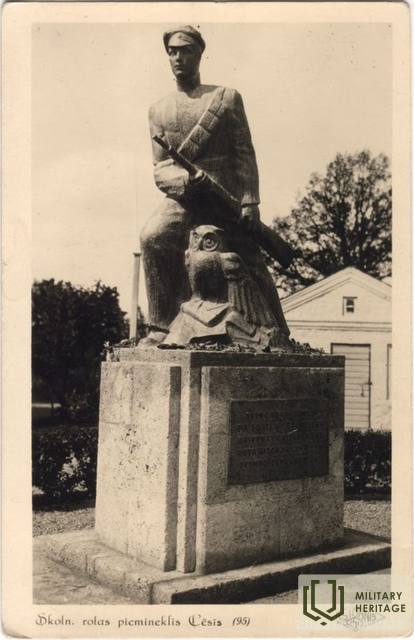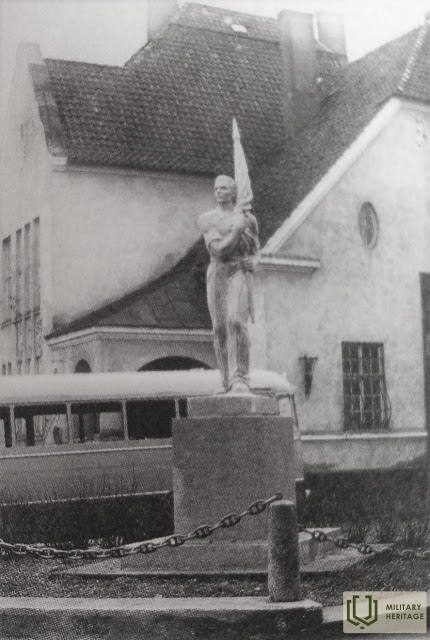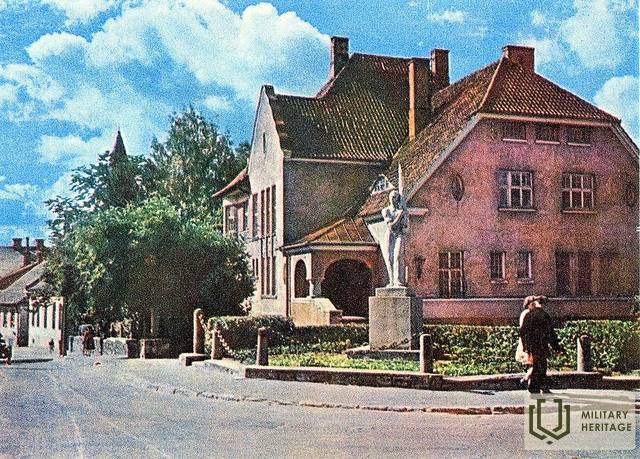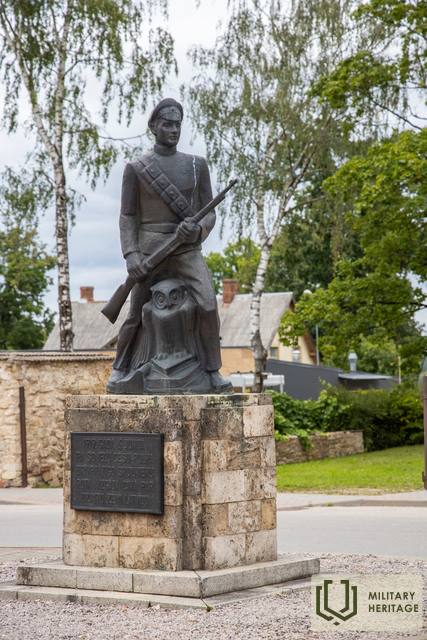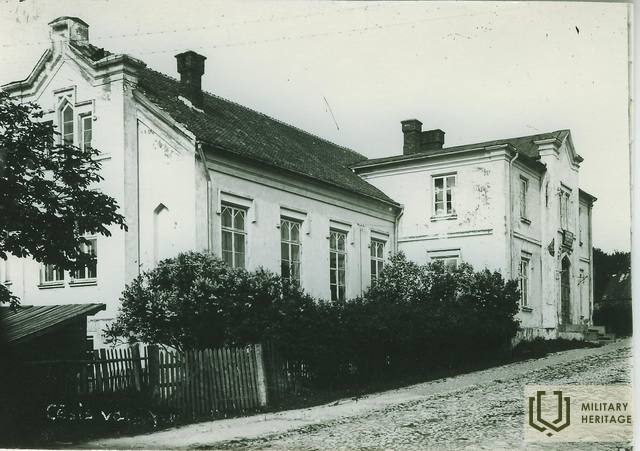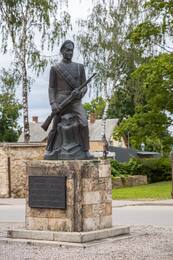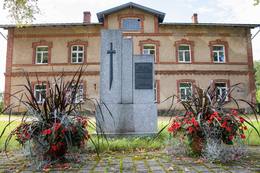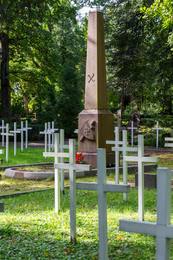The unusual story of the monument to the Cēsis Regiment's School Company
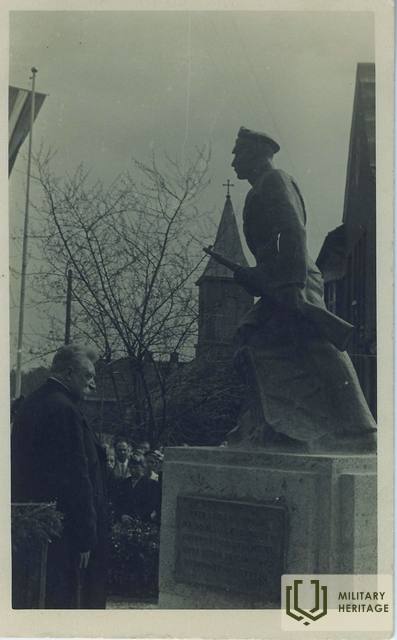
The Cēsis Regiment volunteer schoolboy company participated in the 1919 Cēsis battles, which formed as a combat unit from 108 young people from Valmiera and Cēsis schools on June 5 in the former Cēsis German Progymnasium premises on Dārza Street (now Bērzaines Street 4). Already on the night of June 5 to 6, about an hour after midnight, there was an alarm and the company was ordered to go to positions. The company went out to the Mācītājmuiža – Meijermuiža line, which was considered the most important battle area.
As soon as news of the outbreak of hostilities was received, the battle headquarters or “regiment operational headquarters” immediately moved closer to the front to the house of Dr. med. Vilhelms Lencs at Heermeistera Street No. 16 (now Gaujas Street No. 16). In the early 1930s, this building was purchased by the Cēsis Craftsmen’s Association, but after World War II, the building housed the editorial office and printing house of the newspaper “Padomju Druva” (from March 1990, the newspaper “Druva”). When entering the battlefield, the soldiers of the Schoolboy Company, who had come along Palasta Street from their formation place in the German progymnasium, received grenades at the regimental headquarters. Near the headquarters, the soldiers of the company on Heermeistera (Gaujas) Street had also received a short military briefing. In turn, the command post of the commander of the 2nd Cēsis Infantry Regiment was located just across the street – Heermeistera Street No. 11 (now Gaujas Street No. 11). At the end of the 19th century, this was the “Villa bei Wenden” of the prominent Baltic German archaeologist Georg von Sievers.
A participant in the events on the 10th anniversary of the Battle of Cēsis in the newspaper “Pēdējā Brīdī” (JA“10 years ago the Cēsis Regiment of Students against the Landeswehr.”; 06.06.1929) described what he experienced as follows: “On the night of June 6th, around 1 o’clock, there was an alarm. Everyone quickly got dressed and the regiment of students in 2 platoons stood on Dārza Street, divided into special units, and distributed live ammunition. At the intersection of Rīgas Palasta, Vaļņu and Gaujas Streets, Lieutenant [Gustavs] Grīns showed a short combat maneuver on how to surround a known place. At Dr. Lenčs’ house, hand grenades were distributed, and they were familiarized with their use on the spot. From this place, the company went in the direction of Kalnamuiža, Juruģumuiža and Mācītājmuiža, occupied the central combat zone of the Cēsis Regiment and protected the Meijermuiža – Mācītājmuiža line, turning on.”
On May 26, 1938, approximately 100 m from the former Cēsis German Progymnasium, at the intersection of Dārza and Palasta (now Bērzaines and Palasta) streets, a monument dedicated to the School Company was unveiled. On the night of June 5-6, 1919, students from the progymnasium, untrained in martial arts, went to their first battle. This was symbolized by the student's clumsily grasped rifle, sculpted in bronze. The owl and books at the student's feet also reminded us that school supplies had temporarily been replaced by weapons. The author of the monument's design was the former soldier of the School Company, artist Jānis Rozenbergs (1901-1966), but the idea was realized by sculptor Rūdolfs Ābol(t)iņš (1909-1944) and metalsmith Jānis Zibens (1909-1967).
In 1950, the monument was dismantled as undesirable to the Soviet regime.
When the Awakening began, the first to express the idea of restoring the monument was a group of exiled graduates of the Cēsis State Gymnasium, class of 1942, during their visit to Latvia in 1989. They also began raising the necessary funds for this. However, the Cēsis City Council made the decision to restore the monument and install it in its original location only after Latvia regained its independence on September 24, 1992.
Although an official agreement on the restoration of the monument had barely been reached, in reality work on it had already begun. On September 26, the regional newspaper "Druva" reported that travertine had been prepared for the base of the monument, and sculptor Maija Baltiņa, together with architect Imants Timermanis, had begun creating the bronze statue.
However, on September 30, 1992, a Cēsis resident, Ādolfs Cābulis, who had established contacts with exiles at the beginning of the Revival, seeking support for the installation of the monument, applied to the State Cultural Monuments Protection Inspectorate (VKPAI) and the Committee for the Brothers' Graves (BKK) with an application. He claimed that now the initiative for the restoration of the monument had been taken over by other individuals, who were acting for selfish purposes and had not received the necessary permission from the authorities. Representatives of this group, among whom was also the sculptor Andrejs Jansons, had planned to unveil the monument already on November 11, 1992, placing it approximately 15 meters from its original location. The monument was also planned to undergo significant visual changes, as the soldier designed by J. Rozenbergs held his rifle with his left hand, thus emphasizing the military unpreparedness of the hastily formed Schoolboy Company, while the young man designed by M. Baltiņa held it with his right hand. The material also differed – initially the monument was made of copper, but now it was cast in bronze. In turn, the former bronze plate was replaced with a copper plate.
In order to conduct additional historical research, the Cēsis City Council decided on October 4, 1992 to stop the restoration of the monument, but the creators of the monument did not take this into account and installed a base with steps in the newly chosen location. The need to place the monument there was explained by the changes introduced during the communist occupation in the movement of transport along Bērzaines Street, which were no longer possible to refuse. Although the municipality suggested waiting until next year, when they could try to make a model in nature at the historical location of the monument, the city council's actions were limited by a lack of funds. The already installed base and the made bronze statue had been paid for with funds collected from donations from the Cēsis branch of the Daugava Hawks, exiled Latvians and the Latvian Popular Front. Therefore, a decision was made to unveil the restored monument on November 11, 1992, installing it near the historical location. On November 11, 1992, a monument created by sculptor Maija Baltiņa (1941-2016) was unveiled.
At the same time, in 1992, the monument "Komsomol Flagbearer" by sculptor Kārlis Jansons, erected by the occupation regime, was dismantled.
Tālis Pumpuriņš, Cēsis History and Art Museum
https://karavirukapi.blogspot.com/2020/02/cesis-piemineklis-cesu-pulka-skolnieku.html
http://sovietheritage.blogspot.com/2017/04/cesu-rajona-padomju-laika-zudusie.html
Related timeline
Related topics
Related objects
Monument for students of the Cēsis Regiment
The monument to the soldiers of the Cēsis Regiment Students’ Company who died in the Battles of Cēsis is located in the city of Cēsis, near the intersection of Palasta and Bērzaines streets. The construction of the monument was proposed by the Soldiers’ Association of the Cēsis Regiment Students’ Company. The monument was unveiled on 26 May 1938. The monument is based on the idea sketched by artist Jānis Rozenbergs, a former soldier of the company. Placed on a metre-high limestone pedestal, the 1.8-metre copper sculpture of a soldier dressed in a school student’s uniform was created by sculptor Rūdolfs Āboltiņš and coppersmith Jānis Zibens. An owl, a symbol of wisdom and knowledge, lies at the soldier’s feet, squatting on and protecting the books of a student who went to war. The sculpture was demolished during the Soviet re-occupation in 1952. A monument named the Komsomol Flag Bearer by sculptor Kārlis Jansons was erected near its former location in 1957. Placed near its historic site, the restored monument was unveiled on 11 November 1992. At the same time, in 1992, a monument to the Komsomol, which had been erected by the occupation regime, was taken down.
Monument at the site of the Battle of the Schoolchildren's Company
On the side of the Cēsis-Āraiši highway, near the former Livu parish house.
A monument dedicated to the volunteer student company of the Cēsis Regiment, which participated in the Battle of Cēsis in 1919, can be seen.
The monument was unveiled on May 29, 1930, near the former Livu parish house.
The monument project was developed by former student volunteer K. Dzirkalis, and the installation work was carried out by A. Sproģis' company in Cēsis.
The bronze details were made by M. Pluka according to the author's drawing, and they were cast at the V. Minūtas factory in Riga. After World War II, the monument was destroyed.
Restored on June 6, 1989, the authors of the restored monument were sculptors A. Jansons and M. Baltiņa, and architect I. Timermanis.
Later, the bronze sword and plaque were removed for safety reasons, replaced with wooden parts.
The cemetery of the brothers of the Latvian riflemen who fell in World War I and the soldiers who fell in the War of Independence
Located in the Valmiera City (Center) Cemetery, Lillijas Street 7.
A granite obelisk can be seen, the details of which were forged by sculptor Wilhelm Trey.
The monument was unveiled on June 22, 1923. About 150 soldiers are buried in the fraternal cemetery.
Several fighters of the First World War and the War of Independence are buried in the city cemetery, including the first casualty of the Cēsis Regiment's School Company, LKOK Edgars Krieviņš.
Currently, the section of the fraternal cemetery contains 14 groups of graves of various lengths, on which 139 white wooden crosses have been installed, but the plaques with the names of the fallen, which used to be on the crosses, are no longer there. One black granite cross has survived.
During the communist occupation, intensive civilian burials were carried out in the section of the fraternal cemetery. After the restoration of independence in 1994, the burial layout in the fraternal cemetery was changed, and the grave groups are now arranged crosswise, with only one retaining its former orientation.
Memorial sign at the site of the founding of the Cēsis Regiment's Student Company
Located at Leona Paegles Street 1, near the facade of a red brick building.
The author of the memorial is artist Solveiga Vasiļjeva, and the idea is based on the motif of a flower bud. As the artist points out, it symbolizes personalities that have just begun to form – students who must make an important, responsible and tough decision in their still short lives.
In the form of the memorial, the outer petals of the flower bud are designed geometric, with sharp corners, in contrast with the soft, rounded ones inside the bud. The height of the memorial is up to 1.5m. The memorial was unveiled on May 26, 2011 in Valmiera, at the place where the Cēsis Regiment cadet company was formed in 1919.
The outlines of Latvia are laid out from artificial paving stones, on which a plaque with the flag of the Cēsis Regiment's Pupils' Company and the text is placed lying down:
"In this place on May 26, 1919
"Cēsis Regiment School Company" was founded
Cēsis Brothers' Cemetery
Located in the Cēsis Lower Cemetery, Lenču Street 15, Cēsis.
One of the most significant memorial sites of the First World War and the War of Independence in Cēsis is the Brothers' Cemetery in Lejas Kapis.
The cemetery houses the Brothers' Cemetery Monument, designed by Cēsis artist and councilor Augusts Julla (1872-1958), unveiled in 1927, and dedicated to the soldiers buried in the Brothers' Cemetery from 1915 to 1920.
About 200 soldiers are buried in the Brothers' Graves of the Cēsis Leja Cemetery. Among them are an unknown number of Latvian riflemen and Russian soldiers who fell in World War I, as well as soldiers of German (10), Polish and other nationalities. During the Latvian Liberation Struggles, 22 soldiers of the 5th (2nd) Cēsis Infantry Regiment were buried in this cemetery, as well as 11 freedom fighters who fell in other Latvian army units. 2 Estonians, 15 victims of the Bolsheviks, and Latvian Red Riflemen also rest in the Brothers' Graves.




